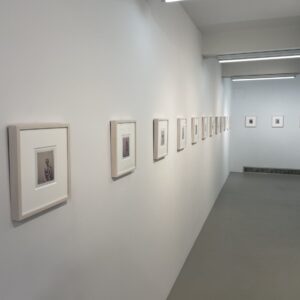JTF (just the facts): A total of 20 color photographs, framed in white and matted, and hung against white walls in the main gallery space and the entry area. All of the works are archival pigment prints, made between 1957 and 1986 and printed later. Each image is available in two sizes: 14×20 inches (or reverse) and 28×38 inches (or reverse), both sizes available in editions of 20. There are 12 images in the 14×20 size and 8 images in the 28×38 size on view. (Installation shots below.)
A monograph of the same name was published in 2017 by Hatje Cantz (here).
Comments/Context: In the past decade or so, the Canadian photographer Fred Herzog has come forward as yet another name that needs to be considered in (or in effect, inserted into) the broad history of color photography. Shooting in Vancouver since the early 1950s, his work was largely unknown until a 2007 exhibit at the Vancouver Art Gallery brought his pictures back into the spotlight, and since that time, a string of gallery and museum shows has increased the momentum of his rediscovery.
Part of the reason that Herzog was previously overlooked was that he shot on Kodachrome color slide film, and it wasn’t until relatively recently that high quality digital prints could be made from his original slides. But with the increased availability of these modern prints (especially in larger exhibition-ready sizes), he has been able to make a more viable case for inclusion among the other better known names (Eggleston, Shore, Sternfeld, and many others) that have typically dominated the color narrative.
In many ways, Herzog’s street photographs exist outside the context of 20th century color photography in America, or perhaps can be seen as a parallel or adjacent category of work. Some of the best images in this show take their cues from Walker Evans’ fascination with vernacular architecture and advertising, extending that interest in lettering, color, and brands out into dense layers of overlapping signage, as seen down city blocks lined with commercial establishments. When flattened by the camera, the eye catching names of hotels, arcades, cafes, and bars become an intricate patchwork of interlocked letter forms. Other images revel in storefronts covered with iconic branding (particularly Coca-Cola), or neighborhood barbershops and their distinctive angled stripes of red, white, and blue.
But Herzog’s photographs never reduce these scenes to abstraction – people are nearly always present, giving his cacophony of visual stimulation both context and counterpoint. His snatched sidewalk portraits often use bold color as a compositional tool. A child’s red leggings match her mother’s skirt, a pink umbrella echoes a pink sign overhead, and a red bike and a red sweater repeat the colors of the soda pop signs nearby. And an overhead view of a bar called the Pink Door uses parked cars and the geometries of adjacent buildings to build up a frame filled with a rainbow of pastels.
When Herzog steps back from the vernacular signage and color studies, the act of looking comes forward as a common theme. Pedestrians crossing Powell Street are spot lit by trapezoids of afternoon sun, an older lady in a red overcoat peers into a storefront window filled with Egyptian antiquities, a cigarette smoking woman turns to look at her family members browsing, and a cafe patron peers out from behind fogged glass. Two images taken at the carnival make this concept of seeing even more explicit, turning impromptu clusters of upturned faces into arranged tableaux, the hopeful eyes of various bettors mesmerized by the turn of the roulette wheel.
In the end, there is a throwback mood to Herzog’s color images that feels wholly innocent (and as a result, a bit dated) – the pictures aren’t obviously freighted with conceptual ideas, art world references, or ironic observation. Instead, the photographs celebrate storefront and streetcorner discoveries with straightforward openness, pulling us back to a simpler time when a torrent of bold lettering felt genuinely optimistic.
Collector’s POV: The prints in this show are priced as follows. The 14×20 inch prints range from $2800 to $4800, while the 28×38 inch prints range from $4800 to $9500, based on the place in the edition. Herzog’s work has little secondary market history at this point, so gallery retail remains the best option for those collectors interested in following up.















